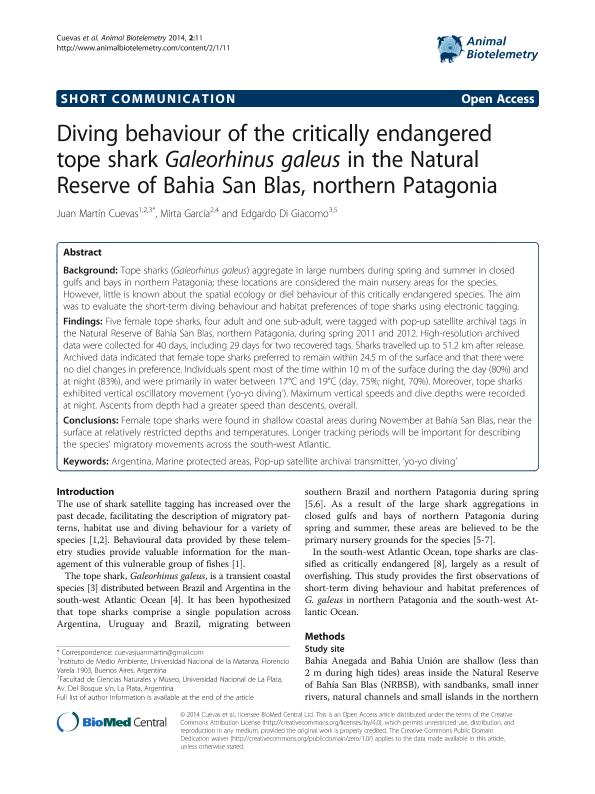Mostrar el registro sencillo del ítem
dc.contributor.author
Cuevas, Juan Martín

dc.contributor.author
Garcia, Mirta Lidia

dc.contributor.author
Di Giacomo, Edgardo Ernesto

dc.date.available
2018-01-09T15:18:27Z
dc.date.issued
2014-07
dc.identifier.citation
Di Giacomo, Edgardo Ernesto; Cuevas, Juan Martín; Garcia, Mirta Lidia; Diving behaviour of the critically endangered tope shark Galeorhinus galeus in the Natural Reserve of Bahia San Blas, northern Patagonia; BioMed Central; Animal Biotelemetry; 2; 11; 7-2014; 1-6
dc.identifier.issn
2050-3385
dc.identifier.uri
http://hdl.handle.net/11336/32651
dc.description.abstract
Background:Tope sharks (Galeorhinus galeus) aggregate in large numbers during spring and summer in closedgulfs and bays in northern Patagonia; these locations are considered the main nursery areas for the species.However, little is known about the spatial ecology or diel behaviour of this critically endangered species. The aimwas to evaluate the short-term diving behaviour and habitat preferences of tope sharks using electronic tagging.Findings:Five female tope sharks, four adult and one sub-adult, were tagged with pop-up satellite archival tags inthe Natural Reserve of Bahía San Blas, northern Patagonia, during spring 2011 and 2012. High-resolution archiveddata were collected for 40 days, including 29 days for two recovered tags. Sharks travelled up to 51.2 km after release.Archived data indicated that female tope sharks preferred to remain within 24.5 m of the surface and that there wereno diel changes in preference. Individuals spent most of the time within 10 m of the surface during the day (80%) andat night (83%), and were primarily in water between 17°C and 19°C (day, 75%; night, 70%). Moreover, tope sharksexhibited vertical oscillatory movement (‘yo-yo diving’). Maximum vertical speeds and dive depths were recordedat night. Ascents from depth had a greater speed than descents, overall.Conclusions:Female tope sharks were found in shallow coastal areas during November at Bahía San Blas, near thesurface at relatively restricted depths and temperatures. Longer tracking periods will be important for describingthe species’migratory movements across the south-west Atlantic.
dc.format
application/pdf
dc.language.iso
eng
dc.publisher
BioMed Central

dc.rights
info:eu-repo/semantics/openAccess
dc.rights.uri
https://creativecommons.org/licenses/by-nc-sa/2.5/ar/
dc.subject
Argentina
dc.subject
Marine Protected Areas
dc.subject
Pop-Up Satellite Archival Transmitter
dc.subject
Yo-Yo Diving
dc.subject.classification
Otras Ciencias Biológicas

dc.subject.classification
Ciencias Biológicas

dc.subject.classification
CIENCIAS NATURALES Y EXACTAS

dc.title
Diving behaviour of the critically endangered tope shark Galeorhinus galeus in the Natural Reserve of Bahia San Blas, northern Patagonia
dc.type
info:eu-repo/semantics/article
dc.type
info:ar-repo/semantics/artículo
dc.type
info:eu-repo/semantics/publishedVersion
dc.date.updated
2018-01-08T18:40:44Z
dc.journal.volume
2
dc.journal.number
11
dc.journal.pagination
1-6
dc.journal.pais
Reino Unido

dc.journal.ciudad
Londres
dc.description.fil
Fil: Cuevas, Juan Martín. Universidad Nacional de la Matanza. Instituto de Medio Ambiente; Argentina. Universidad Nacional de La Plata. Facultad de Ciencias Naturales y Museo; Argentina. Universidad Nacional del Comahue. Instituto de Biología Marina y Pesquera Almirante Storni; Argentina
dc.description.fil
Fil: Garcia, Mirta Lidia. Consejo Nacional de Investigaciones Científicas y Técnicas; Argentina. Universidad Nacional de La Plata. Facultad de Ciencias Naturales y Museo; Argentina
dc.description.fil
Fil: Di Giacomo, Edgardo Ernesto. Universidad Nacional del Comahue. Instituto de Biología Marina y Pesquera Almirante Storni; Argentina
dc.journal.title
Animal Biotelemetry
dc.relation.alternativeid
info:eu-repo/semantics/altIdentifier/doi/http://dx.doi.org/10.1186/2050-3385-2-11
dc.relation.alternativeid
info:eu-repo/semantics/altIdentifier/url/https://animalbiotelemetry.biomedcentral.com/articles/10.1186/2050-3385-2-11
Archivos asociados
